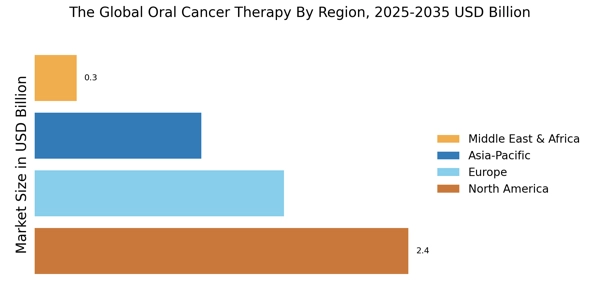Rising Incidence of Oral Cancer
The Global Oral Cancer Therapy Industry is significantly influenced by the rising incidence of oral cancer, which has been linked to various risk factors such as tobacco use, alcohol consumption, and human papillomavirus (HPV) infection. According to recent statistics, oral cancer cases have been on the rise, particularly in developing regions, where access to healthcare may be limited. This alarming trend is driving demand for effective treatment options, thereby propelling market growth. The increasing awareness of oral cancer symptoms and the importance of early detection are also contributing to the heightened focus on therapeutic solutions, further stimulating the market.
Increased Awareness and Education
The Global Oral Cancer Therapy Industry is experiencing growth due to increased awareness and education regarding oral cancer prevention and treatment. Public health campaigns and educational programs are playing a crucial role in informing individuals about the risks associated with oral cancer and the importance of early detection. This heightened awareness is leading to more individuals seeking medical advice and treatment options, thereby driving market demand. Furthermore, healthcare providers are becoming more proactive in screening and diagnosing oral cancer, which is likely to contribute to an increase in the number of patients receiving therapy. This trend underscores the importance of education in shaping market dynamics.
Advancements in Treatment Modalities
The Global Oral Cancer Therapy Industry is witnessing a surge in advancements in treatment modalities, particularly with the introduction of immunotherapy and targeted therapies. These innovative approaches are designed to enhance the efficacy of treatment while minimizing side effects. For instance, the use of monoclonal antibodies has shown promising results in clinical trials, leading to improved patient outcomes. The market is projected to grow significantly, with estimates suggesting a compound annual growth rate (CAGR) of over 7% in the coming years. This growth is largely attributed to the increasing adoption of these advanced therapies, which are becoming more accessible to patients worldwide.
Growing Investment in Research and Development
The Global Oral Cancer Therapy Industry is benefiting from a growing investment in research and development (R&D) initiatives aimed at discovering novel therapeutic agents. Pharmaceutical companies and research institutions are increasingly allocating resources to explore new compounds and treatment strategies. This trend is evidenced by the substantial funding directed towards clinical trials and the development of personalized medicine approaches. As a result, the market is expected to expand, with new therapies entering the pipeline that could potentially revolutionize treatment paradigms. The emphasis on R&D is likely to enhance the competitive landscape, fostering innovation and improving patient care.
Technological Innovations in Treatment Delivery
The Global Oral Cancer Therapy Industry is being transformed by technological innovations in treatment delivery systems. Advances in precision medicine and minimally invasive techniques are enhancing the effectiveness of therapies while reducing recovery times for patients. Technologies such as 3D printing and robotic-assisted surgery are being integrated into treatment protocols, allowing for more accurate targeting of tumors. These innovations not only improve patient outcomes but also streamline the overall treatment process. As technology continues to evolve, it is expected that the market will see a shift towards more efficient and patient-centered care, further driving growth in the industry.


















Leave a Comment